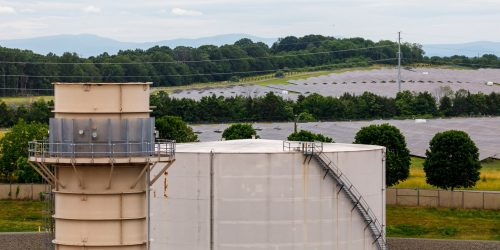Dominion Energy, one of the nation’s largest utilities, in late June erected wind turbines off the Virginia coast — only the second such installation in the United States — as part of a big bet on renewable energy.
The company is also planning to build new power plants that burn natural gas.
Utilities around the country are promoting their growing use of renewable energy like hydroelectric dams, wind turbines and solar panels, which collectively provided more power than coal-fired power plants for the first time last year. But even as they add more green sources of power, the industry remains deeply dependent on natural gas, a fossil fuel that emits greenhouse gases and is likely to remain a cornerstone of the electric grid for years or even decades.
Utilities maintain that they need to keep using natural gas because the wind and the sun are too unreliable. They are also reluctant to invest in energy storage, arguing that it would cost too much to buy batteries that can power the grid when there isn’t enough sunlight or wind.
“We’ve got to have a resource that has an ‘on’ and ‘off’ switch,” said Katharine Bond, vice president for public policy and state affairs at Dominion.
Experts argue that the surge in wind and solar energy, while impressive, is not reducing emissions quickly enough to avert the worst effects of climate change, including more intense heat waves and storms. They argue that utilities urgently need to reduce the use of natural gas, too.
“Replacing coal with gas doesn’t solve our public health problem,” said Mary Anne Hitt, national director of campaigns at the Sierra Club.
Proponents of renewable energy note that solar panels are increasingly the cheapest source of electricity. Solar panels can deliver power to 650 homes for one hour — one megawatt-hour in industry jargon — at $31 to $111 a megawatt-hour, according to Lazard, the investment firm. By comparison, natural gas peaking plants, which utilities can turn on and off quickly to meet surging demand, deliver power at $122 to $162 a megawatt-hour.
A report in June by the University of California, Berkeley, concluded that by 2035, the U.S. electric grid could get 90 percent of its power without greenhouse gas emissions while lowering electricity rates. To do that, the country would have to increase its use of renewables, energy storage and transmission lines while closing all coal plants and slashing natural gas use by 70 percent.
Some lawmakers argue that utilities are wasting billions of dollars by investing in natural gas plants that will have to be shut down before their useful lives end.
“The urgent need to address the climate crisis means we can’t make reckless investments now that will have to be paid off for decades,” said Senator Edward J. Markey, a Massachusetts Democrat and one of the authors of the legislation known as the Green New Deal. “We have to consider clean options, which, fortunately for consumers, are also cost-effective.”
Some experts say they hope that the country can move away from fossil fuels in part because the use of renewables has grown even as the Trump administration has repealed environmental regulations and pulled the United States out of the Paris climate agreement.
“Fighting the transition is not going to stop the transition,” Dennis Wamsted, an analyst for the Institute for Energy Economics and Financial Analysis, said. “Economically, it will happen inevitably.”
Utility executives acknowledge that renewable energy will continue to grow. But many dismiss the idea that wind turbines, solar panels and batteries can replace natural gas plants.





